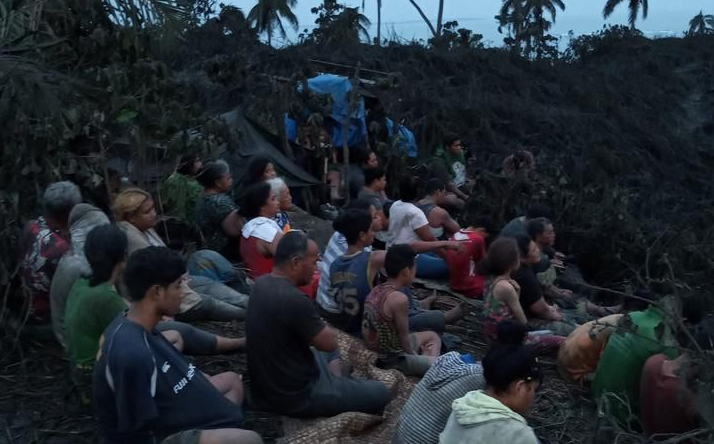An “Unprecedented Disaster”: Underwater Volcano Ravages Pacific Archipelago
- Adiv Sugoto
- Jun 1, 2022
- 3 min read
Updated: Oct 11, 2022
Tonga, the Polynesian kingdom home to 106,000 people and more than 170 islands, will suffer the effects of a historic volcanic eruption. The underwater Hunga Tonga-Hunga Ha’apai volcano, located 40 miles north of the archipelago’s main island, Tongatapu, sits 6,500 feet above the sea floor, and approximately 328 feet above sea level.

On January 13th, after weeks of minor eruptions, the Tonga volcano blasted ash, steam, and gas around 12.4 miles into the stratosphere with a radius of 161.5 miles for more than 12 hours. This eruption was followed by a series of more violent explosions two days later with ejections as high as 19 miles vertically.
According to Jim Garvin, the chief scientist at NASA’s Goddard Space Flight Center, the energy released by the eruption was comparable to somewhere between 4 and 18 megatons of TNT based on the height of the explosion cloud, the displaced land mass, and the resistance of the bedrock—100 times the mechanical energy of the Hiroshima nuclear explosion. In comparison, the notorious Mount St. Helens volcanic explosion of 1980 in the Pacific Northwest released only 24 megatons of energy.

The immense quantity of ash injected into the atmosphere caused a build up and discharge of electricity, resulting in 400,000 lightning strikes within a three hour span The shock waves resulting from the dramatic blast led to drastic air pressure changes felt thousands of miles away in Europe. Furthermore, the sudden displacement of water due to the movement of rock and soil triggered a tsunami that tumbled 6,000 miles across the Pacific.8 Despite Tonga’s relative isolation geography, tsunamis, varying from four to nine feet in height, struck coasts in Australia, New Zealand, Peru, Japan, and the United States’ West coast.
With the nation’s capital, Nuku'alofa, merely 40 miles away from the volcano, the island faced devastating effects as the tsunami reached 2,000 feet inland at a maximum of 49 feet in height. Additionally, when the tsunami struck the main island, Tonga’s internet traffic plunged; communication with and within the country has remained sporadic since, as the major underwater internet cable in the country was severed by tsunami waves. Consequently, there was a substantial delay in aid due to cut communications. Information about the state, as well as the destruction of other inhabited islands within the archipelago, was difficult to retrieve.
Labeled as an “unprecedented disaster” by the Tongan government, the damages from this historic volcanic eruption have been evaluated through aerial surveys, and reports thus far stated that the country’s communications, infrastructure, inter-island shipping vessels, and utilities experienced extensive wreckage.
The cloud of fumes produced by the explosion blanketed Tonga, and the infrastructure, roads, and fields of Nuku’alofa and the remote islands Northeast of the volcano were decimated and coated in black ash. As precipitation occurs across the country, volcanic debris bring toxic hydrogen fluoride into bodies of water, and hence, contaminate essential drinking supplies for the population. Additionally, the significant salt-water intrusion from tsunami waves to ground water has exacerbated the difficulties and shortages with potable water. Kofeola Marian Kapu, a 40-year-old journalist for a radio station in the nation’s capital, expressed that “normally in our homes we have tanks to collect rainwater for drinking, but it’s all covered in ash,” demonstrating the impact of the volcanic debris on drinking water sources for hundreds of thousands of people across the country.

New Zealand and Australia, as well as other neighboring nations, have begun to provide aid—food, water, and tents—to the ravaged inhabited areas of Tonga. Yet, the internet outage prolonged the transfer of these essential supplies, while volcanic ash coated the runways of Tonga’s international airport.
This resulted in more delays, greatly diminishing the effectiveness of foreign aid.
Despite measures to aid the country’s population, Tongan citizens continue to experience the effects of this devastating eruption. With destroyed infrastructure, suffered crops, and limited access to clean water for more than 80% of the country’s people, many Tongans have described their recovery as “a mental transformation.” Even cleaning the nation’s polluted drinking water supply could become a long-term effort, as the process would require extensive desalination projects and the distribution of water-purification tablets. Whether or not the island nation will ever recover remains an open question.

Comments